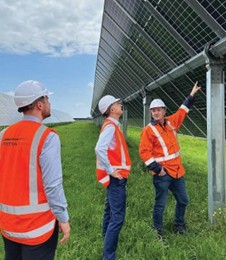Lodestone Energy Turns to Agrivoltaics and Snake Tray® to Maximize Land Use
Solar Snake Max™ enables New Zealand solar farms and sheep grazing to coexist
The Client/Situation
Lodestone Energy Limited is a New Zealand electricity generation company that constructs and operates decentralized photovoltaic power stations. Unlike most utilities that use solar to augment existing fossil fuel-based power generation capabilities, Lodestone produces 100% of its electricity through renewable solar energy. Each solar farm operates independently and is equipped with its own inverters and substation to connect and supply low-cost electricity to the New Zealand power grid.
In December 2024 Lodestone’s third and largest solar farm to date, Te Herenga o Te Rā, achieved first generation and will be fully commissioned by the end of February 2025. Located in Waiotahe, Bay of Plenty, this 42-megawatt farm will generate approximately 69 gigawatt hours of clean renewable electricity annually from over 71,600 high-efficiency bifacial solar panels – enough to power nearly 10,000 Kiwi homes a year! Lodestone plans to build as many as 18 solar farms across New Zealand, accelerating New Zealand’s transition to renewable energy and supporting the nation’s 2050 net-zero emis sion goal.
sion goal.
Lodestone’s success in delivering New Zealand’s first two utility-scale solar farms relied on a network of quality partners, including industry experts such as Kilo Power. The Canadian renewable energy consulting firm specializes in the design of utility-scale solar power generation projects across the globe. Kilo Power’s engineers meticulously architect each Lodestone solar farm to maximize ROI given the unique geography, size, and expected energy yield. They can then complete an accurate bill of materials (BOM) for each farm based on approved blueprints and swiftly proceed with deployment.
The Challenge
While every utility-grade solar plant is different, the Lodestone solar farm projects in New Zealand (three operational, one under construction and more in planning) bring a few interesting twists. Being on the other side of the international date line makes communications challenging at times. Navigating long distance shipping and customs processes from half a world away has some headaches.
But in agrarian-intensive, ecologically minded New Zealand, one of the biggest challenges to solar farm construction is balancing land use for energy production with the country’s valued agricultural sector. In New Zealand agriculture is considered the backbone of the country’s economy and its quality meat, dairy, fruit and wool export products represent the largest sector of its tradeable economy. To accommodate this, Lodestone’s solar farms have successfully adopted an agrivoltaics design enabling traditional agricultural activities like sheep grazing to continue alongside solar energy generation.
The Snake Tray Solar Snake Max™ above ground cable conveyance systems became a stand-out solution based on an optimization conducted by Kilo Power, as it eliminates the need for trenching, reduces cable quantities and still allows for the burgeoning concept of agrivoltaics.
Agriculture + Photovoltaics = Agrivoltaics
Agrivoltaics is a model that allows crops and/or livestock to share the land with solar panels (or photovoltaics) rather than compete for it. While clean, renewable energy sources are desired, a critical issue with solar power is the vast amount of physical space the ar- rays must occupy to generate sufficient electricity to make the investment profitable. (For example, the Te Herenga o Te Rā solar farm occupies over 62.3 hectares/154 acres). To maximize land use and value in New Zealand, agrivoltaics is the answer.
The practice involves installing solar arrays over crops that thrive in partial shade, or in the case of the Lodestone solar farms, placing them above range- land for sheep to graze on the lush grass growing alongside and under the rows of panels. This slows the loss of habitat and offers natural vegetation control. This blended land use offers several synergistic advantages for Lodestone and New Zealand’s sheep farmers, including:
- Reduced emissions and cost of land maintenance. Using gas powered mowers to cut the grass between rows of solar panels is counterintuitive to the whole concept of green energy. Sheep eliminate the cost of labor, fuel and equipment, the production and disposal of clippings, and greenhouse gas emissions from mowing acres of grass.

- Sheep can reach vegetation in small crevices the mowers can- not. They don’t take breaks or vacations and are not impacted by weather or hilly terrain.
- The shade produced by the panels provides relief for livestock during the heat of the day and slows the evaporation of water from the plants and soil. In addition to reducing watering and irrigation requirements it yields greener grasses longer, which positively impacts the tensile strength of sheep wool for a higher quality product.
The Snake Tray Solution
Kilo Power’s Te Herenga o Te Rā solar farm design called for single-axis tracker panels that follow the sun. The modules were mounted on piles driven into the ground to minimize land disruption. The rows were spaced widely apart and high above the ground to allow the sheep to graze safely beneath. The feeder cables from each panel were routed alongside the torque tubes to the end of each row where they were attached to a combiner box. That’s where the Solar Snake Max comes into play.
Snake Tray provided remote consulting, virtual design services and design files to help Kilo Power precisely map out the components for free-air cable conveyance of high ampacity DC cables using Solar Snake Max solutions.
The Solar Snake Max Dual Messenger Wire system was used to convey the high ampacity 750 Kcmil cables carrying DC current from the combiner boxes at the end of each row to the farm substation and out to the grid. These were also mounted on piles positioned high enough to prevent the sheep from rubbing on the cables.
The Solar Snake Max Hard Rail system was used when the cables needed to navigate a free-air road crossing. The galvanized steel hard rails provide the support and framing necessary to change elevations and transverse short distances such as access roads and sheep crossing areas before re-emerging on the other side. Seamless transitions between the messenger wire and hard rail systems are achieved as both use Snake Tray’s patented “click” cable separator mechanism. The underground segments are covered with grated steel plates to continue to allow for free-air cable conveyance without derate.
roads and sheep crossing areas before re-emerging on the other side. Seamless transitions between the messenger wire and hard rail systems are achieved as both use Snake Tray’s patented “click” cable separator mechanism. The underground segments are covered with grated steel plates to continue to allow for free-air cable conveyance without derate.
Provided with a firm BOM developed in step by Snake Tray and Kilo Power, Snake Tray manufactured, packed, and shipped all components as specified for the Te Herenga o Te Rā solar farm.
Business Outcomes
When fully operational the Te Herenga o Te Rā solar farm will produce 42 MWp of power per day, adding to the 66 MWp already supplied by Lodestone’s first two farms.
The certified renewable energy generated by Lodestone’s farms enables its energy-intensive customers to decarbonize their operations more rapidly while regional communities benefit from increased local power supply.
Adopting an agrivoltaics design approach that preserves the site’s agricultural potential and converts land-intensive dairy farms to sheep grazing has wide-reaching appeal. In fact, Lodestone’s first five solar farm projects all have been transformed from dairy farms. By converting to a hybrid land use model of solar generation and sheep grazing, Lodestone is increasing the supply of renewable energy while reducing water consumption, fertilizer use, and the run-off of pollutants and waste associated with traditional dairy farming practices.
Through its harmonious, community-centric design approach to deliver new renew- able energy, coupled with an innovative customer offering, Lodestone has been acknowledged with a range of industry awards in 2024:
customer offering, Lodestone has been acknowledged with a range of industry awards in 2024:
- Building Nations 2024 Award – ‘Infrastructure Decarbonization’
- New Zealand Compare 2024 Supreme Award – ‘Making A Difference’
- Sustainable Business Network 2024 Supreme Award – ‘Disruptive Innovation’
As for the use of the trenchless Snake Tray Solar Snake Max Dual Messenger Wire and Hard Rail solutions, the free-air cable conveyance systems:
- Saved in labor and earth moving equipment costs by eliminating the need to dig trenches and bury cables below the water-table in low lying coastal terrain. The above ground design also allows for easy installation, operation and maintenance.
- Eliminates billable energy lost to derate. All Solar Snake Max systems maintain NEC 310.15 compliant cable separation which allows the cables to operate more efficiently. Heat from electron friction dissipates into the surrounding air, yielding up to 30-watt hours per meter more than bundled cables for maximum energy harvest and a better ROI.
- Saved up to 50% in conductive material costs. Solar Snake Max allowed Lodestone to use half the number of 240mm2 diameter cables to carry 100% of the power load compared to previous sites which needed 2 x 240mm2 per DC pole where the DC cables were buried.
- Reduced disruption to the land, allowing grass to grow and sheep to graze almost immediately after construction.
Snake Tray: Your Partner for Agrivoltaics
Blended solar/agricultural land use is a trend that is taking hold the world over. Snake Tray solutions bring predictability to unpredictable situations, and in this case, new applications. Solar Snake Max systems install quickly, reduce labor and material costs, significantly drive down the total cost of construction, and maximize energy harvest.
Thinking about your next solar farm coexisting with agricultural crops or livestock? Contact us to learn how Snake Tray facilitates dual land use for renewable energy production and maximum value.











.png?r=1940)

